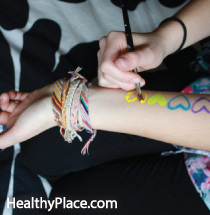Three Alternatives to Self-Injury
There are three alternatives to self-injury that I have found helpful. Some of them are well known, while one is new to me (by which I mean I learned it two days ago). Self-injury borders on being an addiction, and sometimes we can feel obligated to self-injure. However, we need to remember that there are at least three alternatives to self-injury.
Why Do People Self-Injure?
According to The Boston Globe, between two to six percent of Americans self-injure, probably for two or three million different self-injury reasons. Each case is unique, but common themes include
- the need to feel something instead of nothing,
- the desire to punish oneself,
- a cry for help, or, in my case,
- the desire to inflict pain because if I'm not afraid of pain I can override the pain of my current situation and take action to make it better.
Regardless of the reason, self-injury is a serious problem that should not be dismissed (10 Ways People Self-Harm, Self-Injure).
If you've seen warning signs that someone you know self-injures, try to find out what's bothering them. Try to help them face their pain. Most importantly, give them options. Give them alternatives to self-injury.
Self-Injury Alternative One: Glue on the Hands
 Recently I was in a partial hospitalization program because of self-injurious behavior. While there, I picked at the scabs covering the wounds of self-injury. A staff member saw this and suggested I try pouring glue on my hands, letting it dry, then peeling it off. Desperate, I tried it--and it worked.
Recently I was in a partial hospitalization program because of self-injurious behavior. While there, I picked at the scabs covering the wounds of self-injury. A staff member saw this and suggested I try pouring glue on my hands, letting it dry, then peeling it off. Desperate, I tried it--and it worked.
Now obviously you want to do this with child's glue instead of industrial-strength glue. There's something relaxing about peeling off the dried glue--whether it's childhood nostalgia or a therapeutic alternative I do not know. But it works, and that's the important thing about coping skills.
This coping skill works best for people who pick at their wounds.
Self-Injury Alternative Two: Snapping a Rubber Band on the Wrist
If you're the type of person that has to feel pain, this may be a vital coping skill. Snapping a rubber band on the wrist gives the sensation of pain without doing physical damage. It works in a way similar to holding ice on your bare skin--it gives a feeling of pain without any actual harm. This one is probably safer than the ice trick because there's no chance of frostbite. I've never heard of the ice trick causing frostbite, but I wouldn't be surprised if it did hurt someone somewhere.
Not all self-injurers need to feel pain, though. Which leads to the third alternative to self-injury, drawing on yourself with a marker.
Self-Injury Alternative Three: Draw on Self with a Marker
This coping skill works best on a self-injurer who doesn't need the pain but does need the blood. You simply draw red lines where you want to cut. This gives the appearance of injury without the actual damage. I personally have not had a lot of luck with this one because I need the pain, but I do know it has worked for people who are more visual.
A similar concept is The Butterfly Project, in which the person who wants to self-injure draws a butterfly on the spot they want to cut and names it after a loved one. Then you take care of said butterfly like you would a pet. You can't scrub it off. If you cut, it dies. If you stay safe, it lives. This gives some people the ability to pause and rethink what they're about to do.
So those are three alternatives to self-injury. What do you do to avoid self-injury? Leave your comments below.
You can also find Becky Oberg on Google+, Facebook, Twitter and LinkedIn.
APA Reference
Oberg, B.
(2015, August 28). Three Alternatives to Self-Injury, HealthyPlace. Retrieved
on 2025, December 7 from https://www.healthyplace.com/blogs/recoveringfrommentalillness/2015/08/three-alternatives-to-self-injury
Author: Becky Oberg
Most times I am able to catch myself and focus on a puzzle game, empty my head of thoughts. If I can hold out 15 to 30 mins the feeling will pass.
I found these suggestions helpful. They seem similar to me as the first commenters suggestions (sing, dance, saying I love you). Of course, most of us are in counseling so we are dealing with expressing our emotions but having an immediate thing to do (draw or write on ourselves) gives immediate help.
Thank you for writing this blog!
Read the book Bodily Harm by Dr. Wendy Lader, PhD. Work at not self injuring by identifying and expressing feelings rather than substituting similiar behaviors.
These suggestions are full of stupidity. pour a poisonous chemical on my hands so it seeps into the blood stream making me even more insane than i already am. these ideas are stupid as is anyone who except diagnoses.
To avoid self injury i remind myself to breathe, i go for a walk or a bike ride or a swim, i sit with a book and allow myself to escape temporarily until the waves of neurosis pass. i look in the mirror and tell myself i love you. I sing, i dance, i spin around. I vocalize the best i know how with the words to express any emotion i feel. i walk away from people as not to project the feelings or insecurities. many things other than pouring glur on my hands...that is stupid and I'm not sure that the person writing this article is any expert on mental health.